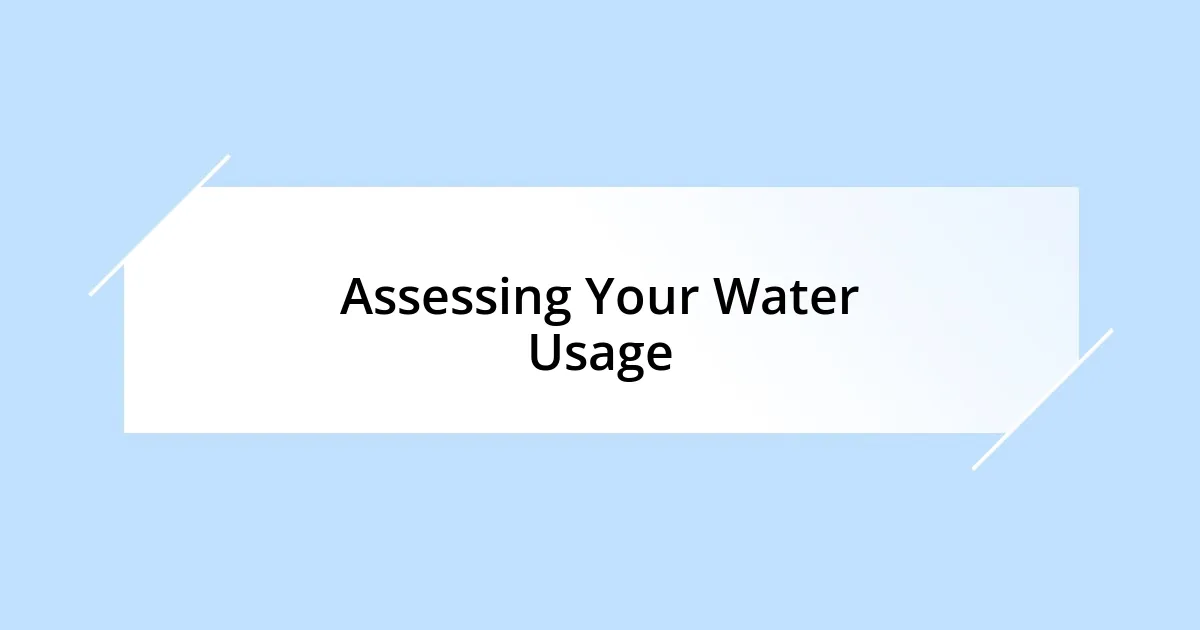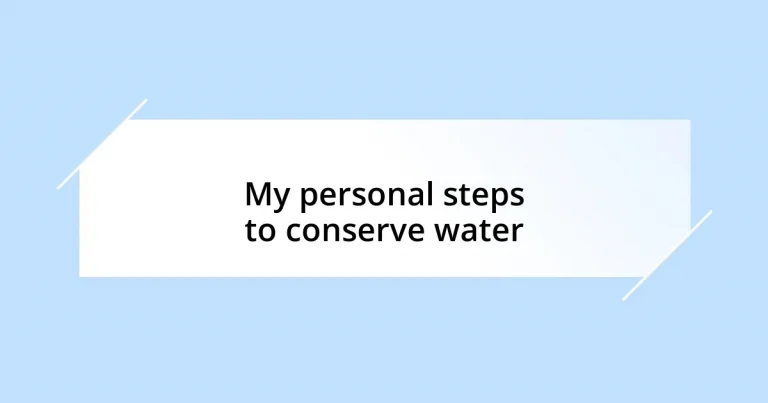Key takeaways:
- The water crisis affects nearly 2 billion people globally, highlighting the urgent need for water conservation efforts.
- Implementing small changes in daily habits, such as tracking water usage and using smart appliances, can lead to significant water savings and environmental benefits.
- Community initiatives, like xeriscaping and rain gardens, not only conserve water but also enhance local ecosystems and biodiversity.
- Tracking progress through logs or apps can motivate individuals and foster collective action towards sustainable water use.

Understanding the Water Crisis
The water crisis, an issue that often feels distant until it hits home, is a stark reality for millions around the world. I remember a time when my community faced a severe drought; it was eye-opening to see families rationing water as if it were a luxury. Have you ever had to turn off the tap while brushing your teeth? It’s a small change, but it drives home the point of how precious water truly is.
It’s heartbreaking to think that nearly 2 billion people lack access to safe drinking water. I once visited a region where families had to travel miles just to fill jerry cans from a contaminated source. This experience made me question how I use water daily. Am I doing enough? This isn’t just about running out of water; it impacts health, education, and economic stability.
As we acknowledge this crisis, it’s important to recognize that climate change is amplifying challenges associated with water supply. Each summer, I watch my garden wilt in the heat, reminding me of the fragile balance we must maintain with nature. If we don’t take action now, what will our water future look like? Our choices today echo through generations, and we owe it to ourselves—and to our children—to make sustainability a priority.

Impact of Water Conservation
The impact of water conservation is profound, reaching into various facets of daily life. When I switched to low-flow fixtures in my home, I not only noticed smaller water bills but also felt a sense of accomplishment. It’s incredible how small changes can ripple outward, affecting the broader environment by reducing overall water consumption.
Every drop saved contributes to a healthier ecosystem. I once joined a local cleanup event near a riverbank, where volunteers discussed how conserving water prevents pollution and helps maintain natural habitats. It’s a striking realization: our efforts to save water can directly enhance the quality of life for many creatures, big and small. Have you thought about how your water use affects local wildlife?
On a larger scale, when communities embrace water-saving practices, the economic benefits can be significant. In my town, an initiative to promote xeriscaping—landscaping that reduces or eliminates the need for irrigation—led to not just water savings, but also increased beauty and biodiversity in public spaces. This reinforced my belief that conserving water isn’t just an individual effort, but a communal journey toward sustainability.
| Impact of Water Conservation | Examples |
|---|---|
| Environmental Benefits | Reduced water pollution and enhanced ecosystems |
| Economic Savings | Lower water bills and increased efficiency |
| Community Engagement | Local initiatives like xeriscaping promoting biodiversity |

Assessing Your Water Usage
To truly assess your water usage, start by paying attention to where it’s going each day. I remember keeping a log for a week, noting every instance of water use—from washing dishes to filling up the kettle. It was a bit of a revelation. I realized that little habits, like longer showers or running the dishwasher half-full, added up to significant waste. Once you recognize these patterns, you can make targeted adjustments.
Here are some practical steps for assessing your own water consumption:
– Track Your Daily Use: Keep a water diary for a week to identify high-usage areas.
– Check for Leaks: Regularly inspect faucets and toilets for leaks, which could waste gallons unknowingly.
– Evaluate Consumption: Note how much water is needed for various activities, like laundry, cooking, and cleaning.
– Set Goals: After analyzing your usage, establish specific, measurable goals for water reduction.
– Educate Yourself: Research the average water usage for common household tasks to gauge your habits.
Understanding these details not only fosters awareness but also ignites a sense of responsibility. When I compared my habits against the averages, I was shocked to see where I stood. It drove home the point that everyone’s choices matter. Each effort—no matter how small—contributes to a larger movement towards sustainable water use. That’s the kind of understanding that can change lives.

Simple Habits to Save Water
Developing simple habits can significantly reduce water usage without requiring drastic lifestyle changes. I remember the first time I committed to turning off the tap while brushing my teeth. It seemed like a small act, but over time, I realized that I was saving a substantial amount—around eight gallons a day! How many things do we do mindlessly that could be changed with just a little awareness?
Another effective habit I’ve cultivated is collecting cold water while waiting for the shower to warm up. Initially, it felt a bit quirky, but I used that water to nourish my indoor plants. It’s fulfilling to see them thrive, knowing I’m contributing both to their wellbeing and to conservation efforts. Have you thought about how you could repurpose that wait time?
Lastly, I’ve found that shortening my shower time to five minutes has had a lasting impact. I set a timer and challenge myself to stick to it, often surprising myself with how refreshing a quick shower can be. It’s a little competition that builds a sense of achievement—and all the while, I know I’m saving gallons of water. Have you ever timed your showers? You might be amazed at what you discover!

Smart Appliances for Water Savings
The inclusion of smart appliances has truly transformed my approach to conserving water at home. I’ll never forget the excitement I felt when I purchased a modern washing machine that includes a “water saver” feature. Not only does it adjust the water level based on the load size, but I’ve noticed my water bill drop significantly each month. Have you checked out the settings on your own appliances? It might surprise you how much water you could save just by utilizing these smart features.
Dishwashers have also come a long way in terms of efficiency. When I invested in my new model, I was shocked to learn it uses less water than washing dishes by hand, especially when I let it run only when fully loaded. It’s not just about saving water; it’s also about freeing up my time. Who wouldn’t want to swap scrubbing for a few more minutes with a good book? Those minutes add up, making me wonder—how much time could you reclaim with an efficient appliance?
Another favorite of mine is the smart irrigation system I installed in my garden. I had always struggled with overwatering, but now, these systems calculate the exact moisture levels in the soil and adjust the watering schedule accordingly. I recall the first week I used it; I felt a sense of relief knowing my plants were getting what they truly needed, without the worry of wasting water. Does your garden get the love it deserves, or do you find it a bit chaotic? Sometimes, embracing technology can turn that chaos into something truly beautiful.

Outdoor Water Conservation Tips
One of the best outdoor water conservation tips I’ve embraced is creating a rain garden. When I first dug mine, I was surprised at the amount of runoff from my roof that I could actually capture. It’s not just about conserving water; it’s also a beautiful addition to my yard that attracts butterflies and birds. Have you ever thought about how nature can help us with conservation? It’s like a reminder of the balance we need to maintain.
Another practice I’ve found beneficial is using mulch in my garden beds. After I started mulching, my plants thrived, and I was amazed at how less often I needed to water. Mulch acts as a protective layer, keeping moisture in the soil and preventing weeds. It’s so satisfying to know that I’m minimizing water usage while also helping my plants stay healthy. How often do you check if your garden is getting the right amount of water?
Finally, I can’t stress enough how much drip irrigation has changed my gardening routine. I’ll never forget the relief I felt when I installed it and saw my water usage decrease dramatically. This system delivers water directly to the roots, ensuring that my plants get just what they need without waste. Watching the savings pile up on my water bill each month feels like finding a hidden treasure. Have you explored the benefits of drip systems in your own outdoors? You might just fall in love with the efficiency.

Tracking Your Water Saving Progress
Tracking my water-saving progress has become both a satisfying and revealing journey. I started by keeping a simple log of my monthly water usage, comparing the numbers with previous months. It’s surprising how much motivation comes from seeing those figures decline. Have you ever taken the time to analyze your bills? It’s a bit like tracking a fitness goal; seeing tangible results can really energize you to keep pushing forward.
I’ve also found that using apps dedicated to water conservation has taken my efforts to the next level. There was a moment when I realized just how many small adjustments I was making—like reducing shower time or fixing leaks—but I hadn’t fully appreciated their impact until I saw the app’s data visualization. The thrill of hitting water-saving milestones feels like celebrating personal victories. Do you have a method for tracking your progress? Finding a tool that works for you can make all the difference.
Lastly, sharing my results with friends and family has sparked some interesting conversations. I remember chatting with a neighbor about our shared goal of conserving water, and we ended up challenging each other to reduce our usage further. It’s funny how peer accountability can turn a simple habit into a community effort. Have you considered discussing your water-saving goals with someone? You might find some unexpected allies in your quest to conserve more water!














